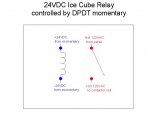151027-2155 EDT
Wire 2 Race:
What is a relay? It is some device that upon receipt of an input signal actuates something to produce a controlled output. This could be a pressure switch where a diaphragm pushes on a microswitch so that when the input air pressure reaches a certain pressure that sufficient movement of the actuator occurs to change the state of the microswitch. In general a relay is an amplifier, meaning a small input signal can control a large output. Isolation between input and output is generally a property of a relay.
Most relays you think of are electromechanical with an input coil to create a magnetic field when a current is applied. Thre magnetic field via an armature moves a contact to open or close a circuit.
Attached is a photo of the side of a P&B KUP 11D15 24 V DC. This relay can switch a 10 A load at 120 V (1200 W) with 24 V at 450 ohms (53 mA) 1.28 W. Thus the power amplification is 1000.

In the photo you can see one terminal of the relay coil and its connection to one tab on the relay base. The other end of the coil is on the other side of the relay.
At the top right you see the SPDT contact structure and the center contact is supported by a leaf spring that via a flexible wire connects to the tab next to the relay coil tab. The relay in its present position is de-energized and the normally closed path is to the upper tab. When the relay is energized the center contact moves to the lower contact and this is the called the normally open contact.
You can easily test a plug-in relay by pulling it from its socket and applying the correct voltage and frequency to the coil. You can also measure coil resistance. If you have doubts about a relay bench test it.
You should be able to look inside an "ice cube" relay and see in what state it is.
You can ignore your control switches and apply an appropriate voltage to the "ice cube" relay to see if it controls your contactor. If things work correctly here, then you need to work on the control wiring and switches to see where your problem is.
Your control switches are wired in what I call a "wired or" circuit. That is the normally open switch contacts are wired in parallel. Thus, any one or more switches when closed produce a logic one or true condition. One set of contacts on a switch are used to set the contactor on, and the other set of contacts to set the contactor off.
.



